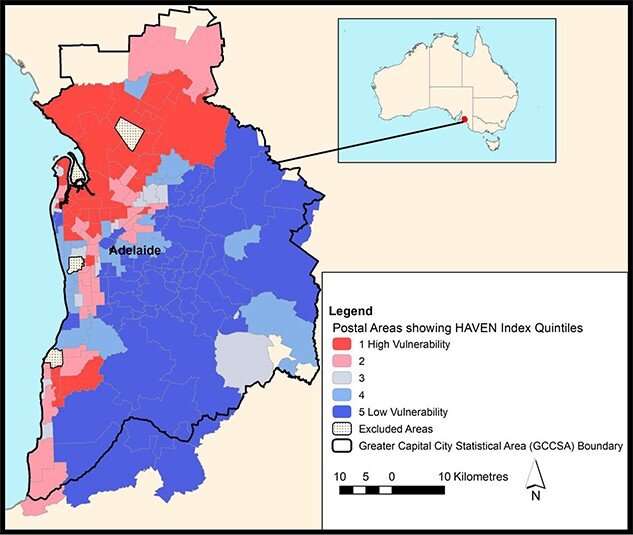Aging in place successfully could be all about where you live

Research from the University of Adelaide has shown that neighborhood characteristics—from the location of medical services and how much green space there is, to the number of people involved in volunteer activities—can have a significant impact on older people's ability to age successfully at home.
09 mar 2022--Researchers from the Adelaide Geriatrics Training and Research with Aged Care Centre (GTRAC) and the NHMRC Centre of Research Excellence in Frailty and Healthy Aging have developed a sophisticated new measure known as the Healthy Aging/Vulnerable ENvironment index, or HAVEN, to evaluate how complex aspects of neighborhood environments can influence the health and wellbeing of older people.
Lead researcher and post-doctoral fellow Dr. Danielle Taylor says the development of the index has been the first stage in mapping out, not only the kinds of environmental factors that support aging in place, but also what factors may make older people more vulnerable in the community.
In the first study to use the HAVEN index, "A vulnerable residential environment is associated with higher risk of mortality and early transition to permanent residential aged care for community dwelling older South Australians," published in Age and Ageing today, the research team has mapped 142 Adelaide postcode areas to determine those where people over 65 years are most vulnerable or most protected.
The study used retrospective data from the Registry of Senior Australians (ROSA) database looking at older people living in metropolitan Adelaide and receiving their first eligibility assessment for aged care services between 2014 and 2016.
"HAVEN employs a deficit accumulation model where we assessed more than 40 variables across six indicator groups—income and employment; education; housing and health; social connectedness; geographical access; and physical environment—to develop composite indicators," Dr. Taylor says.
"While environments are by their nature complex, using the HAVEN index, we have shown that neighborhood environments are significantly associated with the health and wellbeing of older people and the ability of older Australians seeking care to age in place."
Dr. Taylor says outcomes from the recent Royal Commission into Aged Care Quality and Safety show that most Australians would prefer to stay in their homes for as long as possible, rather than transitioning into aged care.
"Keeping older Australians independent, active, healthy and happy for longer is a worthy goal, not only because of the benefit to them, but also because of the economic benefit it can deliver." Dr. Taylor says.
"We are not simply talking about savings to the public purse through their reduced need for health services, but also the productivity gains brought about by the contributions older Australians make to the economy and society when they are able to age well.
"Analysis using the HAVEN index has clearly shown that to best support healthy aging, we need to better understand and optimize the environmental factors that support that goal.
"Identifying the geographic differences in neighborhoods and regions where mortality and entry into permanent residential aged care is high or low gives us a basis for targeted local environment interventions to improve vulnerable areas, reduce inequalities and help all Australians age well."
Director of the University of Adelaide's GTRAC and member of the World Health Organization's Clinical Consortium of Healthy Aging, Professor Renuka Visvanathan, says the research is especially relevant in the context of the United Nation's Healthy Aging Decade (2021–2023).
"This is a period where internationally, we are focussing our efforts on developing a more comprehensive understanding of the many factors that contribute to successful aging," Professor Visvanathan says.
"This research is making an important contribution to our knowledge of how both the health characteristics of individuals, and the environments in which they live, influence their ability to achieve healthy aging."
No comments:
Post a Comment